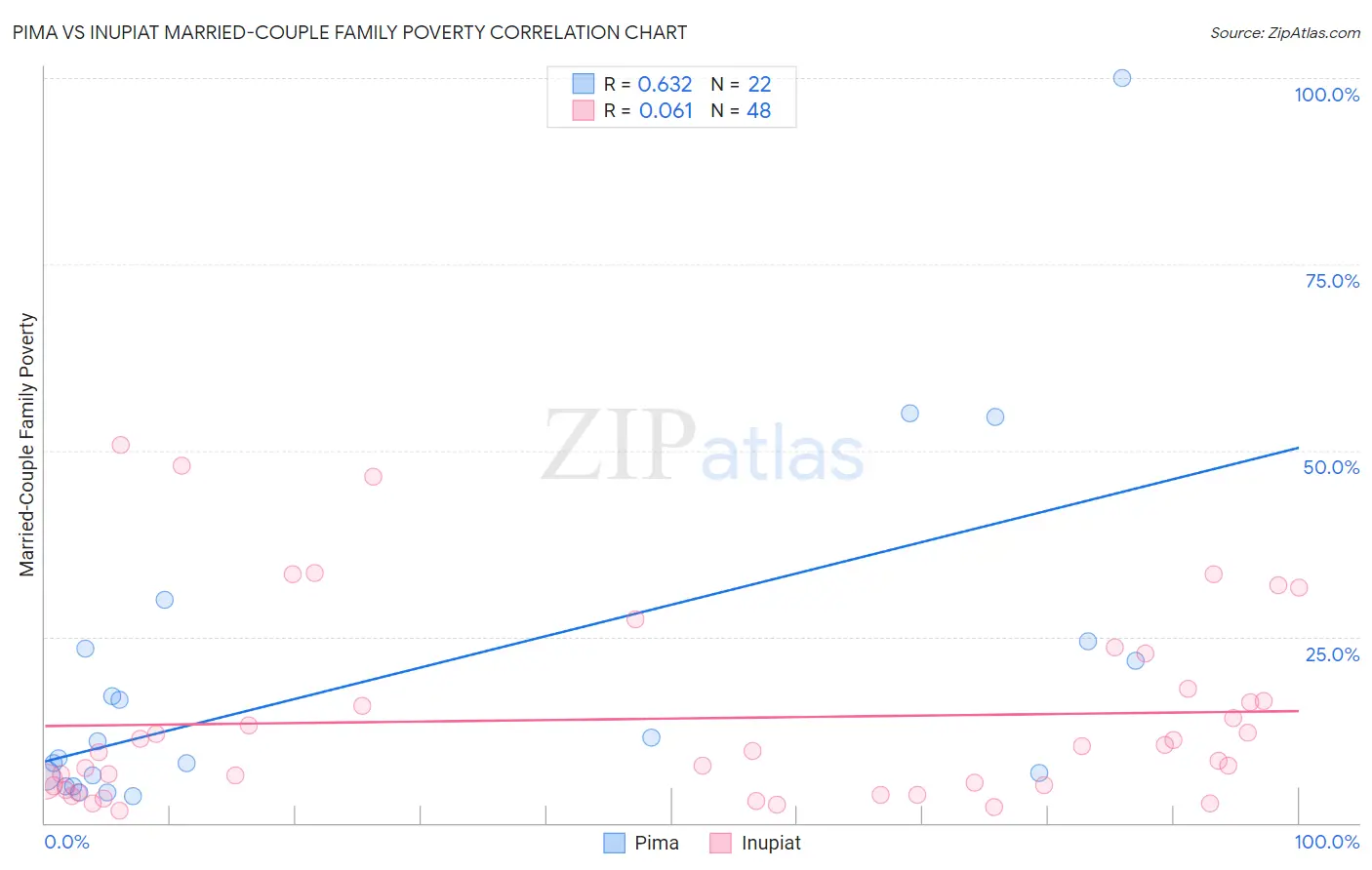Pima vs Inupiat Married-Couple Family Poverty
COMPARE
Pima
Inupiat
Married-Couple Family Poverty
Married-Couple Family Poverty Comparison
Pima
Inupiat
11.4%
MARRIED-COUPLE FAMILY POVERTY
0.0/ 100
METRIC RATING
343rd/ 347
METRIC RANK
7.1%
MARRIED-COUPLE FAMILY POVERTY
0.0/ 100
METRIC RATING
315th/ 347
METRIC RANK
Pima vs Inupiat Married-Couple Family Poverty Correlation Chart
The statistical analysis conducted on geographies consisting of 61,466,640 people shows a significant positive correlation between the proportion of Pima and poverty level among married-couple families in the United States with a correlation coefficient (R) of 0.632 and weighted average of 11.4%. Similarly, the statistical analysis conducted on geographies consisting of 96,004,773 people shows a slight positive correlation between the proportion of Inupiat and poverty level among married-couple families in the United States with a correlation coefficient (R) of 0.061 and weighted average of 7.1%, a difference of 59.7%.

Married-Couple Family Poverty Correlation Summary
| Measurement | Pima | Inupiat |
| Minimum | 3.6% | 1.6% |
| Maximum | 100.0% | 50.7% |
| Range | 96.4% | 49.0% |
| Mean | 19.6% | 14.0% |
| Median | 9.9% | 9.6% |
| Interquartile 25% (IQ1) | 6.4% | 4.7% |
| Interquartile 75% (IQ3) | 23.4% | 17.2% |
| Interquartile Range (IQR) | 17.0% | 12.5% |
| Standard Deviation (Sample) | 23.2% | 12.9% |
| Standard Deviation (Population) | 22.7% | 12.8% |
Similar Demographics by Married-Couple Family Poverty
Demographics Similar to Pima by Married-Couple Family Poverty
In terms of married-couple family poverty, the demographic groups most similar to Pima are Tohono O'odham (11.2%, a difference of 1.7%), Pueblo (11.1%, a difference of 2.6%), Navajo (11.9%, a difference of 3.9%), Puerto Rican (12.6%, a difference of 10.8%), and Immigrants from Yemen (12.8%, a difference of 12.2%).
| Demographics | Rating | Rank | Married-Couple Family Poverty |
| Lumbee | 0.0 /100 | #333 | Tragic 8.3% |
| Immigrants | Dominican Republic | 0.0 /100 | #334 | Tragic 8.4% |
| Sioux | 0.0 /100 | #335 | Tragic 8.7% |
| Apache | 0.0 /100 | #336 | Tragic 9.0% |
| Yakama | 0.0 /100 | #337 | Tragic 9.0% |
| Cheyenne | 0.0 /100 | #338 | Tragic 9.4% |
| Crow | 0.0 /100 | #339 | Tragic 9.6% |
| Yuman | 0.0 /100 | #340 | Tragic 9.7% |
| Pueblo | 0.0 /100 | #341 | Tragic 11.1% |
| Tohono O'odham | 0.0 /100 | #342 | Tragic 11.2% |
| Pima | 0.0 /100 | #343 | Tragic 11.4% |
| Navajo | 0.0 /100 | #344 | Tragic 11.9% |
| Puerto Ricans | 0.0 /100 | #345 | Tragic 12.6% |
| Immigrants | Yemen | 0.0 /100 | #346 | Tragic 12.8% |
| Yup'ik | 0.0 /100 | #347 | Tragic 13.4% |
Demographics Similar to Inupiat by Married-Couple Family Poverty
In terms of married-couple family poverty, the demographic groups most similar to Inupiat are Honduran (7.2%, a difference of 0.15%), British West Indian (7.1%, a difference of 0.24%), Mexican (7.2%, a difference of 0.47%), Immigrants from St. Vincent and the Grenadines (7.1%, a difference of 0.54%), and Immigrants from Guatemala (7.2%, a difference of 0.63%).
| Demographics | Rating | Rank | Married-Couple Family Poverty |
| Spanish American Indians | 0.0 /100 | #308 | Tragic 7.1% |
| Hopi | 0.0 /100 | #309 | Tragic 7.1% |
| Immigrants | Nicaragua | 0.0 /100 | #310 | Tragic 7.1% |
| Immigrants | Dominica | 0.0 /100 | #311 | Tragic 7.1% |
| Immigrants | Armenia | 0.0 /100 | #312 | Tragic 7.1% |
| Immigrants | St. Vincent and the Grenadines | 0.0 /100 | #313 | Tragic 7.1% |
| British West Indians | 0.0 /100 | #314 | Tragic 7.1% |
| Inupiat | 0.0 /100 | #315 | Tragic 7.1% |
| Hondurans | 0.0 /100 | #316 | Tragic 7.2% |
| Mexicans | 0.0 /100 | #317 | Tragic 7.2% |
| Immigrants | Guatemala | 0.0 /100 | #318 | Tragic 7.2% |
| Immigrants | Latin America | 0.0 /100 | #319 | Tragic 7.2% |
| Immigrants | Grenada | 0.0 /100 | #320 | Tragic 7.3% |
| Immigrants | Caribbean | 0.0 /100 | #321 | Tragic 7.3% |
| Immigrants | Honduras | 0.0 /100 | #322 | Tragic 7.3% |